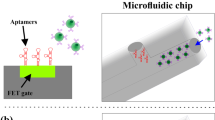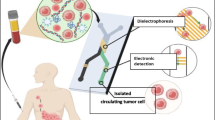Abstract
Emerging microfluidic technologies involving miniaturization for high throughput and integration with various on-line detection modalities hold intriguing advantages for cancer diagnosis, tumor microenvironment modeling, and drug evaluation. This book chapter overviews recent advances in diagnosis and therapy for head and neck cancer using microfluidic-based techniques. The basic working principles and experimental results of key microfluidic platforms for head and neck cancer biomarker analysis, cancer cell detection at single-cell levels, and tumor-on-chip model reconstruction for therapeutic assessment and drug evaluation are introduced.
Access this chapter
Tax calculation will be finalised at checkout
Purchases are for personal use only
Similar content being viewed by others
References
Vigneswaran N, Williams MD. Epidemiological trends in head and neck cancer and aids in diagnosis. Oral Maxillofac Surg Clin North Am. 2014;26:123–41.
Jemal A, et al. Global cancer statistics. CA Cancer J Clin. 2011;61:69–90.
Sabaila A, Fauconnier A, Huchon C. Cancer incidence and mortality worldwide: sources, methods and major patterns in GLOBOCAN 2012. Int J Cancer. 2015;43:66–7.
Pires FR, et al. Oral squamous cell carcinoma: clinicopathological features from 346 cases from a single Oral pathology service during an 8-year period. J Appl Oral Sci. 2017;21:460–7.
Noguti J, et al. Metastasis from oral cancer: an overview. Cancer Genomics Proteomics. 2012;9:329–36.
Akbulut N, Altan A. Early detection and multidisciplinary approach to oral cancer patients. Prevention, detection and management of oral cancer (ed. Sundaresan, S.) 13 (IntechOpen, 2018).
Yakob M, Fuentes L, Wang MB, Abemayor E, Wong DTW. Salivary biomarkers for detection of oral squamous cell carcinoma: current state and recent advances. Curr Oral Heal Rep. 2014;1:133–41.
Rivera C. Essentials of oral cancer. Int J Clin Exp Pathol. 2015;8:11884–94.
Cognetti DM, Weber RS, Lai SY. Head and neck cancer: an evolving treatment paradigm. Cancer. 2008;113:1911–32.
Sackmann EK, Fulton AL, Beebe DJ. The present and future role of microfluidics in biomedical research. Nature. 2014;507:181–9.
Ahn J, Sei Y, Jeon N, Kim Y. Tumor microenvironment on a chip: the progress and future perspective. Bioengineering. 2017;4:64.
Mark D, Haeberle S, Roth G, Von Stetten F, Zengerle R. Microfluidic lab-on-a-chip platforms: requirements, characteristics and applications. Chem Soc Rev. 2010;39:1153–82. https://doi.org/10.1039/b820557b.
Ren K, Zhou J, Wu H. Materials for microfluidic chip fabrication. Acc Chem Res. 2013;46:2396–406.
Ashley JF, Cramer NB, Davis RH, Bowman CN. Soft-lithography fabrication of microfluidic features using thiol-ene formulations. Lab Chip. 2011;11:2772–8.
Zips S, et al. Direct stereolithographic 3D printing of microfluidic structures on polymer substrates for printed electronics. Adv Mater Technol. 2019;4:1–5.
Coluccio ML, et al. Microfluidic platforms for cell cultures and investigations. Microelectron Eng. 2019;208:14–28.
Duncombe TA, Tentori AM, Herr AE. Microfluidics: reframing biological enquiry. Nat Rev Mol Cell Biol. 2015;16:554–67.
Tehranirokh M, Kouzani AZ, Francis PS, Kanwar JR. Microfluidic devices for cell cultivation and proliferation. Biomicrofluidics. 2013;7:1–32.
Wang X, Liu Z, Pang Y. Concentration gradient generation methods based on microfluidic systems. RSC Adv. 2017;7:29966–84.
Kim SH, Lee GH, Park JY, Lee SH. Microplatforms for gradient field generation of various properties and biological applications. J Lab Autom. 2015;20:82–95.
Luka G, et al. Microfluidics integrated biosensors: a leading technology towards lab-on-A-chip and sensing applications. Sensors (Switzerland). 2015;15:30011–31.
Eze N, Lo Y-C, Burtness B. Biomarker driven treatment of head and neck squamous cell cancer. Cancers Head Neck. 2017;2:1–12.
Ferrari D, et al. Role of plasma EBV DNA levels in predicting recurrence of nasopharyngeal carcinoma in a western population. BMC Cancer. 2012;12:208.
Pandya D, Nagarajappa AK, Reddy S, Bhasin M. Lab-on-a-Chip-oral cancer diagnosis at your door step. J Int Oral Heal. 2015;7:122–8.
Thomas GR, Nadiminti H, Regalado J. Molecular predictors of clinical outcome in patients with head and neck squamous cell carcinoma. Int J Exp Pathol. 2005;86:347–63.
Hayes B, Murphy C, Crawley A, O’Kennedy R. Developments in point-of-care diagnostic technology for cancer detection. Diagnostics. 2018;8:39.
Rackus DG, Shamsi MH, Wheeler AR. Electrochemistry, biosensors and microfluidics: a convergence of fields. Chem Soc Rev. 2015;44:5320–40.
Mauk MG, Ziober BL, Chen Z, Thompson JA, Bau HH. Lab-on-a-chip technologies for oral-based cancer screening and diagnostics: capabilities, issues, and prospects. Ann N Y Acad Sci. 2007;1098:467–75.
Soares AC, et al. Microfluidic-based genosensor to detect human papillomavirus (HPV16) for head and neck cancer. ACS Appl Mater Interfaces. 2018;10:36757–63.
Weigum SE, et al. Nano-Bio-Chip sensor platform for examination of oral exfoliative cytology. Cancer Prev Res. 2010;3:518–28.
Malhotra R, et al. Ultrasensitive detection of cancer biomarkers in the clinic using a nanostructured microfluidic array. Anal Chem. 2012;84:6249–55.
Wang A, Wang CP, Tu M, Wong DTW. Oral biofluid biomarker research: current status and emerging frontiers. Diagnostics. 2016;6:PMC5192520.
Herr AE, et al. Microfluidic immunoassays as rapid saliva-based clinical diagnostics. Proc Natl Acad Sci. 2007;104:5268–73.
Kaczor-Urbanowicz KE, et al. Emerging technologies for salivaomics in cancer detection. J Cell Mol Med. 2017;21:640–7.
Khan R, Khurshid Z, Yahya Ibrahim Asiri F. Advancing Point-of-Care (PoC) testing using human saliva as liquid biopsy. Diagnostics. 2017;7:39.
Zilberman Y, Sonkusale SR. Biosensors and bioelectronics microfluidic optoelectronic sensor for salivary diagnostics of stomach cancer. Biosens Bioelectron. 2015;67:465–71.
Herr AE, et al. Integrated microfluidic platform for oral diagnostics. Ann N Y Acad Sci. 2007;1098:362–74.
Gau V, Wong D. Oral Fluid Nanosensor Test (OFNASET) with advanced electrochemical-based molecular analysis platform. Ann N Y Acad Sci. 2007;1098:401–10.
Wang Z, et al. A microfluidic chip-based fluorescent biosensor for the sensitive and specific detection of label-free single-base mismatch via magnetic beads-based ‘sandwich’ hybridization strategy. Electrophoresis. 2013;34:2177–84.
Lin YH, et al. Detection of anti-p53 autoantibodies in saliva using microfluidic chips for the rapid screening of oral cancer. RSC Adv. 2018;8:15513–21.
López-Verdín S, et al. Molecular markers of anticancer drug resistance in head and neck squamous cell carcinoma: a literature review. Cancers (Basel). 2018;10:1–15.
Canning M, et al. Heterogeneity of the head and neck squamous cell carcinoma immune landscape and its impact on immunotherapy. Front Cell Dev Biol. 2019;7:1–19.
Reese JB, et al. Single-cell transcriptomic analysis of primary and metastatic tumor ecosystems in head and neck cancer. Cell. 2018;123:4757–63.
He CK, Chen YW, Wang SH, Hsu CH. Hydrodynamic shuttling for deterministic high-efficiency multiple single-cell capture in a microfluidic chip. Lab Chip. 2019;19:1370–7.
Runge J, et al. Evaluation of single-cell biomechanics as potential marker for oral squamous cell carcinomas: a pilot study. Oral Dis. 2014;20:120–7.
Weigum SE, Floriano PN, Christodoulides N, McDevitt JT. Cell-based sensor for analysis of EGFR biomarker expression in oral cancer. Lab Chip. 2007;7:995–1003.
Abram TJ, et al. Development of a cytology-based multivariate analytical risk index for oral cancer. Oral Oncol. 2019;92:6–11.
Abram TJ, et al. Cytology-on-a-chip’ based sensors for monitoring of potentially malignant oral lesions. Oral Oncol. 2016;60:103–11.
Mulhall HJ, et al. Cancer, pre-cancer and normal oral cells distinguished by dielectrophoresis. Anal Bioanal Chem. 2011;401:2455–63.
Broche LM, et al. Early detection of oral cancer – is dielectrophoresis the answer? Oral Oncol. 2007;43:199–203.
Adekanmbi EO, Srivastava SK. Dielectrophoretic applications for disease diagnostics using lab-on-a-chip platforms. Lab Chip. 2016;16:2148–67.
Cheung KC, et al. Microfluidic impedance-based flow cytometry. Cytom Part A. 2010;77:648–66.
Yang L, Arias LR, Lane TS, Yancey MD, Mamouni J. Real-time electrical impedance-based measurement to distinguish oral cancer cells and non-cancer oral epithelial cells. Anal Bioanal Chem. 2011;399:1823–33.
Tsai HF, Peng SW, Wu CY, Chang HF, Cheng JY. Electrotaxis of oral squamous cell carcinoma cells in a multiple-electric-field chip with uniform flow field. Biomicrofluidics. 2012;6:34116.
Perumal V, et al. Circulating tumour cells (CTC), head and neck cancer and radiotherapy; future perspectives. Cancers (Basel). 2019;11:1–25.
Maremanda NG, et al. Quick chip assay using locked nucleic acid modified epithelial cell adhesion molecule and nucleolin aptamers for the capture of circulating tumor cells. Biomicrofluidics. 2015;9:1–20.
Kulasinghe A, Zhou J, Kenny L, Papautsky I, Punyadeera C. Capture of circulating tumour cell clusters using straight microfluidic chips. Cancers (Basel). 2019;11:1–11.
Kulasinghe A, et al. Enrichment of circulating head and neck tumour cells using spiral microfluidic technology. Sci Rep. 2017;7:1–10.
Liu T, et al. A microfluidic device for characterizing the invasion of cancer cells in 3-D matrix. Electrophoresis. 2009;30:4285–91.
Li X, et al. Downregulation of miR-218-5p promotes invasion of oral squamous cell carcinoma cells via activation of CD44-ROCK signaling. Biomed Pharmacother. 2018;106:646–54.
Li J, et al. Carcinoma-associated fibroblasts lead the invasion of salivary gland adenoid cystic carcinoma cells by creating an invasive track. PLoS One. 2016;11:1–15.
Chen YC, et al. Single-cell migration chip for chemotaxis-based microfluidic selection of heterogeneous cell populations. Sci Rep. 2015;5:1–13.
Kim HS, et al. Endothelial-derived interleukin-6 induces cancer stem cell motility by generating a chemotactic gradient towards blood vessels. Oncotarget. 2017;8:100339–52.
Ayuso JM, et al. Study of the chemotactic response of multicellular spheroids in a microfluidic device. PLoS One. 2015;10:1–16.
Tan CP, et al. Parylene peel-off arrays to probe the role of cell-cell interactions in tumour angiogenesis. Integr Biol. 2009;1:587–94.
Liu L, et al. Biomimetic tumor-induced angiogenesis and anti-angiogenic therapy in a microfluidic model. RSC Adv. 2016;6:35248–56.
Kochanek SJ, Close DA, Johnston PA. High content screening characterization of head and neck squamous cell carcinoma multicellular tumor spheroid cultures generated in 384-well ultra-low attachment plates to screen for better cancer drug leads. Assay Drug Dev Technol. 2019;17:17–36.
Tanaka N, et al. Head and neck cancer organoids established by modification of the CTOS method can be used to predict in vivo drug sensitivity. Oral Oncol. 2018;87:49–57.
Ong LJY, et al. A 3D printed microfluidic perfusion device for multicellular spheroid cultures. Biofabrication. 2017;9:45005.
Al-samadi A, et al. In vitro humanized 3D microfluidic chip for testing personalized immunotherapeutics for head and neck cancer patients. Exp Cell Res. 2019;383:111508.
Jin D, et al. Application of a microfluidic-based perivascular tumor model for testing drug sensitivity in head and neck cancers and toxicity in endothelium. RSC Adv. 2016;6:29598–607.
Hsieh CC, Huang S, Bin W, C P, Shieh DB, Lee GB. A microfluidic cell culture platform for real-time cellular imaging. Biomed Microdevices. 2009;11:903–13.
Bower R, et al. Maintenance of head and neck tumor on-chip: gateway to personalized treatment? Futur. Sci. OA. 2017;3:FSO174.
Cheah R, et al. Measuring the response of human head and neck squamous cell carcinoma to irradiation in a microfluidic model allowing customized therapy. Int J Oncol. 2017;51:1227–38.
Hattersley SM, et al. A microfluidic system for testing the responses of head and neck squamous cell carcinoma tissue biopsies to treatment with chemotherapy drugs. Ann Biomed Eng. 2012;40:1277–88.
Kennedy R, et al. A patient tumour-on-a-chip system for personalised investigation of radiotherapy based treatment regimens. Sci Rep. 2019;9:1–10.
Tanweer F, Green VL, Stafford ND, Greenman J. Application of microfluidic systems in management of head and neck squamous cell carcinoma. Head Neck. 2014;36:1391.
Riley A, et al. A novel microfluidic device capable of maintaining functional thyroid carcinoma specimens ex vivo provides a new drug screening platform. BMC Cancer. 2019;19:1–13.
Sylvester D, Hattersley SM, Stafford ND, Haswell SJ. Development of microfluidic-based analytical methodology for studying the effects of chemotherapy agents on cancer tissue. Curr Anal Chem. 2012;9:2–8.
Sylvester D, Hattersley S, Haswell S. Development of microfluidic based devices for studying tumour biology and evaluating treatment response in head and neck cancer biopsies. 14th Int Conf Miniaturized Syst Chem Life Sci. 2010:1472–4.
Author information
Authors and Affiliations
Corresponding author
Editor information
Editors and Affiliations
Rights and permissions
Copyright information
© 2021 Springer Nature Switzerland AG
About this chapter
Cite this chapter
Yang, Y., Wang, H. (2021). Microfluidic Technologies for Head and Neck Cancer: From Single-Cell Analysis to Tumor-on-a-Chip. In: El Assal, R., Gaudilliere, D., Connelly, S.T. (eds) Early Detection and Treatment of Head & Neck Cancers. Springer, Cham. https://doi.org/10.1007/978-3-030-69859-1_3
Download citation
DOI: https://doi.org/10.1007/978-3-030-69859-1_3
Published:
Publisher Name: Springer, Cham
Print ISBN: 978-3-030-69858-4
Online ISBN: 978-3-030-69859-1
eBook Packages: MedicineMedicine (R0)




